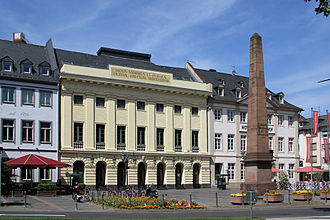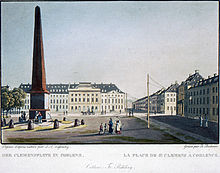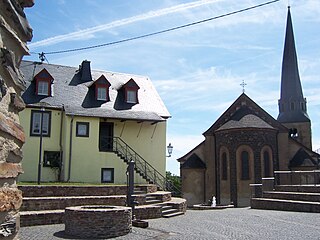
Kaisersesch is a town in the Cochem-Zell district in Rhineland-Palatinate, Germany. It is the administrative seat of the like-named Verbandsgemeinde, to which it also belongs.

Polch is a town in the district Mayen-Koblenz, Rhineland-Palatinate, Germany. It is part of the Verbandsgemeinde of Maifeld. It is situated east of Mayen.

Dominique Caillat is a Swiss playwright and writer. She lives in Berlin and works in German, French and English.

The Electoral Palace in Koblenz, was the residence of the last Archbishop and Elector of Trier, Clemens Wenceslaus of Saxony, who commissioned the building in the late 18th century. In the mid-19th century, the Prussian Crown Prince had his official residence there during his years as military governor of the Rhine Province and the Province of Westphalia. It now houses various offices of the federal government.

Koblenz-Ehrenbreitstein station is the only station on the right (eastern) bank in the city of Koblenz in the German state of Rhineland-Palatinate. It is on the East Rhine railway at the foot of the Ehrenbreitstein hill in the Ehrenbreitstein district, next to the Rhine.

Mainz Römisches Theater station is a station in the city of Mainz, the capital of the German state of Rhineland-Palatinate on the Main Railway from Mainz to Frankfurt am Main. It is the most important station in the city after Mainz Hauptbahnhof. It is classified by Deutsche Bahn as a category 3 station. The station is served by S-Bahn and regional trains.

Langen (Hess) station is in the town of Langen in the German state of Hesse. It was opened in 1846 with the Main-Neckar Railway and is now served by the Rhine-Main S-Bahn. The station has two side platforms, an island platform and a through track without a platform. The station building and platform canopies are protected as monuments. It is classified by Deutsche Bahn as a category 4 station.
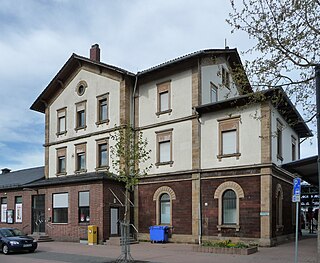
Grünstadt station is a railway junction where the Palatine Northern Railway connects with the Eis Valley Railway and the disused tracks of the Leiningen Valley Railway and the Worms–Grünstadt railway. It is one of three stations in the urban area of Grünstadt in the German state of Rhineland-Palatinate. The station's entrance building of 1873 as well as parts of the premises are protected as monuments. It is classified by Deutsche Bahn as a category 4 station.
The following is a timeline of the history of Koblenz, Germany.

The Upper Germanic-Rhaetian Limes, or ORL, is a 550-kilometre-long section of the former external frontier of the Roman Empire between the rivers Rhine and Danube. It runs from Rheinbrohl to Eining on the Danube. The Upper Germanic-Rhaetian Limes is an archaeological site and, since 2005, a UNESCO World Heritage Site. Together with the Lower Germanic Limes it forms part of the Limes Germanicus.
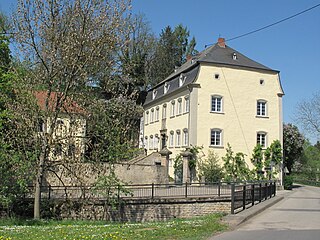
Schloss Holsthum, also called Herrenhaus Laeis, is a manor house in the municipality of Holsthum in the county of Eifelkreis Bitburg-Prüm in the German state of Rhineland-Palatinate. It is a cultural monument and listed building.

Schauenburg Castle is a ruined hilltop castle located in Oberkirch, Germany, atop a 367-metre-high (1,204 ft) (NN) hill spur overlooking the Rench river valley above the town of Gaisbach, Baden-Württemberg. The castle was built by Duke Berthold II of Zähringen.

The Ehrenburg is the ruin of a spur castle at 230 m above sea level (NN) in the vicinity of Brodenbach in Germany. The castle had a very eventful history. It was built on a rocky spur in the valley of the Ehrbach, a right bank valley of the Moselle. Once the fortified heart of a small imperial barony with estates between the Lower Moselle and Middle Rhine, it is today a cultural monument that hosts numerous events.

The Old Castle was a former Elector-owned, substantial water castle in the German city of Koblenz, incepted in the 13th century. It is today reduced to the later Burghaus ; which houses the city archives. It sits on tall foundations and has a tall, black slate roof with further floors in the attic and two small cupolas. The lowland castle abutted the remaining building in the old town quarter. The castle house stands tall, next to the Moselle's right-bank towpath downstream of the strategic Baldwin Bridge built in 1342. The bridge, much-repaired, remains intact.

Ehrang station is, after Trier Hauptbahnhof, the second most important station in the city of Trier in the German state of Rhineland-Palatinate. The station forms a railway junction with a former marshalling yard that is still partly used as a freight yard. At the station, the Eifel Railway from Cologne connects with the Koblenz–Trier railway. Until 1983, Ehrang station was also the starting point of the Trier West Railway to Igel that connected with Wasserbillig / Luxembourg.
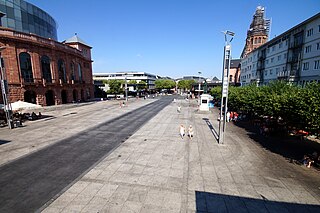
The Gutenbergplatz is an important square in the German city of Mainz, in terms of building culture and urban development. It was named after Johannes Gutenberg, who was born in Mainz. Gutenbergplatz is the largest and most important square in the city centre of Mainz. Due to its social and urban history, the square has been designated a monument zone.

The Griffin cannon, also called Vogel Greif,, is one of the largest cannons from the 16th century. Since 1984, it has been in display in the Ehrenbreitstein Fortress in Koblenz. The possession of the cannon moved several times between Germany and France and became a symbol of the Franco-German reconciliation.
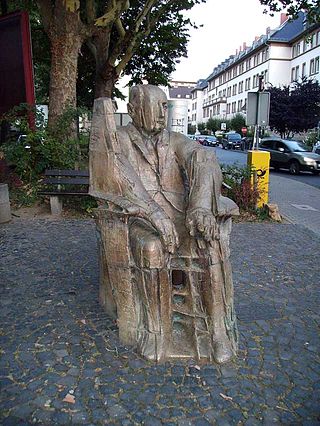
Fritz Michel was a German physician, politician, historian and art historian.
Herbert Dellwing was a German art historian and historic preservationist. He lived and work in Speyer and Neustadt an der Weinstraße.

Koblenz Charterhouse was a Carthusian monastery, or charterhouse, in Koblenz, Rhineland-Palatinate, Germany. It stood on the Beatusberg, a hill that forms the north-easterly tip of the Hunsrück overlooking the city. The site was first occupied by a Benedictine monastery, the Kloster St. Beatusberg, which was closed in 1315, when the monks were replaced by a community of Augustinian Canons until the Carthusians took over the site in 1331.
